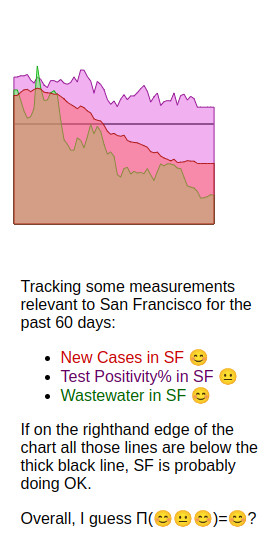I continue to watch my little dashboard of San Francisco COVID-19 numbers to figure out if activities like in-person grocery shopping are ordinary errands or dangerous stunts. I watch a few numbers. Folks argue about which number to watch; and I roll my eyes: folks have settled on a few numbers to watch that are all pretty good. And because they're all pretty good, they tend to agree. Except except except not lately, not in San Francisco (and, I bet, not in California generally).

In late March, the numbers were above the pretty-safe line (argh), but slowly drifting down (yay). Then, in the first week of April, the state of California relaxed a bunch of restrictions on hospitals. Many people who periodically had to get tested didn't have to anymore. Maybe ½ to ⅔ as many tests took place each day.
The absolute number of new cases reported in San Francisco continued to fall. (That's the red line on my graph.) Did that mean that COVID-19 was in decline in SF? The fraction of tests in San Francisco that game back positive (the purple graph line) stopped falling; instead, it held steady. Did that mean that COVID-19 was holding on in SF, but that you might think it was in decline because fewer asymptomatic-but-infected people were getting tested?
It makes sense that the fraction of positive tests might not decline as fast as the fraction of infected people. San Francisco reports statistics for the super-duper official PCR tests administered by medical professionals. If some unhappy person gives themselves an at-home test and it's positive, that person then goes to get a super-duper official test so that their health insurance will pay for their treatment. There aren't many of these almost-certainly-infected people getting tested compared to the number of probably-not-infected hospital-people; but starting in early April, the fraction of almost-certainly-infected people went up, because many probably-not-infected hospital-people stopped getting tested.
In hindsight, I think COVID-19 really is in decline in SF. I say that because the excellent folks at our wastewater plants are finding less COVID-19. (That's the green-brown line on my graph.). Normally, I don't pay much attention to the wastewater-COVID numbers from day to day. Those measurements are very noisy! You're looking at my graph and saying "that looks pretty jagged; you should smooth out those numbers" and I'm telling you: those are the smoothed-out numbers. If you pay too-close attention to the wastewater numbers, one day you think "OMG we cured the COVID last week but somehow it didn't make the news" and the next day you think "OMG COVID runs rampant in the streets and we are all doomed." But the wastewater numbers don't care that a bunch of hospital-people no longer need to get tested periodically. Everybody in San Francisco, uhm, contributes to our wastewater tests. And though that graph is very jagged, it's also trending down.
So instead of waiting for that purple line to descend to a "safe" level, I guess I'll just multiply together the numbers I have, compare them to the multiplied-together "safe" numbers, and act accordingly. In happier times, I might keep an eye for some smartie on Twitter to pipe up with a well-researched new "safe" level. But as Twitter continues to implode…if some smartie does try to post there, there's no guarantee that I'd notice.
Anyhow, I guess I'll go grocery shopping in-person soon; and I'll keep on keeping on looking at my little dashboard to decide whether to do things in-person or to re-retreat.
